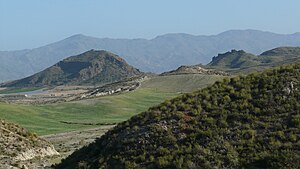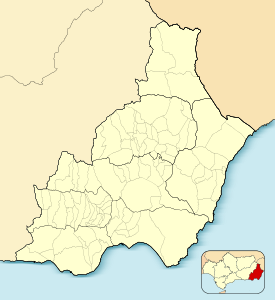Cabezo María
| Cabezo María | ||
|---|---|---|
|
The Cabezo María south of Antas , a former volcano from Verit |
||
| height | 225 msnm | |
| location | Almeria Province , Spain | |
| Mountains | Sierra de Cabrera | |
| Coordinates | 37 ° 12 '43 " N , 1 ° 55' 57" W | |
|
|
||
| rock | Verit | |
| Age of the rock | by 7.2 million years BP ( Messinian ) | |
The Cabezo María is a conical mountain with a diameter of 550 meters, which represents the eroded remains of a former volcanic center. It is located a little north of the Sierra de Cabrera in the southern municipality of Antas in the province of Almería , about 7 kilometers southwest of Vera . It consists of the very rare igneous rock Verit .
Geological overview
The Verite building up the Cabezo María is a phlogopite lamproit belonging to the lamproites. This Potassian igneous rock forms part of the southeast Iberian volcanic province , in which, in addition to numerous other volcanic rocks, more than ten remains of shallow intrusions and volcanic centers of lamproitic composition can be found (mainly in the province of Murcia ). Lamproic volcanism occurred in the Miocene and spanned 8.3 to 6.7 million years BP . The distribution of the lamproites is closely related to the basins created by stretching the crust and, in particular, to their boundary faults. These basins were filled with continental and marine sediments within the Betic and Sub-Betic during the Neogene .
construction
The current remains of the former volcano cover an area of 0.16 square kilometers and have a volume of 3.5 million cubic meters. Inside the cone the following sequence can be seen (from hanging wall to lying ):
- covering lavas
- clearly layered slag (Scoria)
- massive, block-like lava with partly columnar discharge
- Peperite
The sequence suggests the following development of the volcano: along an east-south-east trending staggered fracture zone, lamproic magma penetrated into still wet, unconsolidated marl sediments of the shallow water area. When the magma came into contact with water, phreatomagmatic explosions occurred, which led to the formation of peperites, which penetrated the surrounding sediment in places and lifted it. The peppers were then covered by a new surge of magma with a massive lava flow. Afterwards, pyroclastics rising up on the conveyor tunnels rained down in several pulses, which gradually built up a layered cinder and ash cone over the lava flow , which finally appeared above the water level. Gravitational instabilities led to slippage on the emerging scoria cone. In the final phase of the volcano, the activities on the conveyor channel shifted deeper, but one last lava flow was emitted, which covered the volcanic building like a cap.
Petrology
mineralogy
The phenocrystals in the Verit des Cabezo María are chromium- containing, forsterite- rich olivine with the composition Fo 90-95 and acicular to tabular phlogopite. The glassy base mass, which takes up to over 70 percent by volume, contains microcrystals of phlogopite, diopside, sanidine , leucite and apatite . Secondary calcite has formed in bubble-shaped cavities . Occasional xenocrystals of olivine can be found in the rock , which contain inclusions of spinel and suggest a place of origin in the upper mantle .
Chemical composition
Main and trace elements
| Oxide wt.% |
Massive lava range |
Brecciated lava | Block lava | Blistered gangue rock | Trace elements ppm |
Massive lava range |
Brecciated lava | Block lava | Blistered gangue rock |
|---|---|---|---|---|---|---|---|---|---|
| SiO 2 | 55.81-59.30 | 57.75 | 58.95 | 57.36 | Cr | 528-646 | 577 | 505 | 592 |
| TiO 2 | 1.40-1.47 | 1.47 | 1.45 | 1.40 | Ni | 250-291 | 365 | 357 | 362 |
| Al 2 O 3 | 11.37-12.05 | 11.80 | 11.96 | 11.54 | Zn | 62.2-70.2 | 67.3 | 66.9 | 64.4 |
| Fe 2 O 3 | 3.95-5.99 (dead) | 4.91 (dead) | 4.74 (dead) | 4.86 (dead) | Rb | 549-592 | 631 | 607 | 570 |
| FeO | Sr | 458-501 | 435 | 448 | 445 | ||||
| MnO | 0.05-0.09 | 0.08 | 0.07 | 0.07 | Zr | 769-814 | 799 | 782 | 751 |
| MgO | 2.53-5.41 | 3.07 | 3.94 | 4.72 | Ba | 1641-1815 | 1676 | 1674 | 1552 |
| CaO | 2.74-4.29 | 4.65 | 3.51 | 4.76 | Ce | 287-298 | 297 | 289 | 278 |
| Na 2 O | 2.34-2.94 | 3.31 | 3.09 | 3.16 | Nd | 165-170 | 170 | 166 | 160 |
| K 2 O | 4.50-5.12 | 3.58 | 4.09 | 3.61 | Sm | 29.0-29.8 | 29.8 | 29.2 | 28.0 |
| P 2 O 5 | 0.79-0.82 | 0.84 | 0.82 | 0.78 | Hf | 20.0-20.7 | 20.6 | 20.1 | 19.4 |
| LOI | 7.15-7.52 | 7.66 | 6.42 | 7.03 | Th | 96.8-101.7 | 99.7 | 98.7 | 94.5 |
| K / Na | 1.15-1.27 | 0.71 | 0.87 | 0.75 | |||||
| K / Al | 0.43-0.46 | 0.33 | 0.37 | 0.34 | |||||
| (Na + K) / Al | 0.77-0.86 | 0.79 | 0.79 | 0.79 |
The Verit of Cabezo Maria is an intermediate composition having a relatively high content of Na 2 O (up to about 3 weight percent), but as compared to other South East of Spain with 3.6 Lamproiten relatively low to 5.1 percent by weight K 2 O . Nevertheless, it falls under the Potassian series in Middlemost's (1975) discrimination diagram. With (Na + K) / Al <1 the volcanic rock is completely metaluminos and in this respect resembles the lamproites of the Roman magma province .
The trace element concentrations are quite comparable to the values measured in other Verites, but are significantly higher than, for example, the calcareous-alkaline volcanic rocks of Cabo de Gata . Enrichments can be seen in the HFSE thorium , uranium , lead (very pronounced), neodymium and gadolinium . Negative spikes have niobium , strontium and titanium . Overall, a very strong accumulation of the incompatible elements can be observed. This indicates a multi-phase development of the mantle source with magma secretions and renewed metasomatic enrichment processes.
Age
The Cabezo María had penetrated the neogene sediments of the Vera basin during the Tortonian / Messinian . It represents in it the westernmost occurrence of a series of four further lamproic eruption centers, all of which are associated with the Palomares fault , a significant left-hand, north-northeast trending lateral shift. In general, the period of 8.3 to 6.7 million years BP is estimated for the Lamproitic volcanism in south-east Spain, whereby an accumulation of volcanic activities can be observed in the period 7.3 to 7.2 million years BP.
Radiometric age dating for the Cabezo María comes from Nobel and colleagues (1981) and from Bellido Mulas and Brändle Matesanz (2011). The former found a very old age of 8.6 million years BP, the latter only 7.45 ± 0.08 million years BP. However, these two dates contradict the age of the intruded marls, sandstones and turbidites , which are younger than 7.246 million years BP and therefore suggest an age of 7.2 million years BP for the formation of the volcano.
Global Geosite
Because of its petrological interest, the Cabezo María was proposed by the Instituto Geológico y Minero de España as a Global Geosite of international relevance. It bears the designation VU004 - volcanic center of the Cabezo María and ranks under the geological category of Neogene and Quaternary volcanism of the Iberian Peninsula .
Individual evidence
- ↑ Duggen, S. et al .: Post-collisional transition from subduction to intraplate-type magmatism in the westernmost Mediterranean: evidence for continental-edge delamination of subcontinental lithosphere . In: Journal of Petrology . tape 46 , 2005, pp. 1155-1201 .
- ↑ Montenat, C. et al .: La faune rongeurs de Librilla. Corrélation avec les formations marins du Miocène terminal et les datations radiométriques du volcanisme de Barqueros (Province de Murcia, Espagne méridionale) . In: CR Acad. Sci. Paris . tape 281 , 1975, pp. 519-522 .
- ↑ Gernon, TM et al .: Emplacement of the Cabezo María lamproite volcano (Miocene, SE Spain) . In: Bull. Volcanol. tape 77:52 , 2015, p. 1-13 .
- ↑ Middlemost, EAK: The basalt clan . In: Earth-Science Review . tape 11 , 1975, p. 337-364 .
- ↑ Turner, SP et al: Magmatism associated with orogenic collapse of the Betic-Alboran domain, SE Spain . In: Journal of Petrology . tape 40 (6) , 1999, pp. 1011-1036 .
- ↑ Playà, E. and Gimeno, D .: Evaporite deposits and coeval volcanism in the Fortuna Basin (Neogene, Murcia, Spain) . In: Sedimentary Geology . tape 188-189 , 2006, pp. 205-218 .

